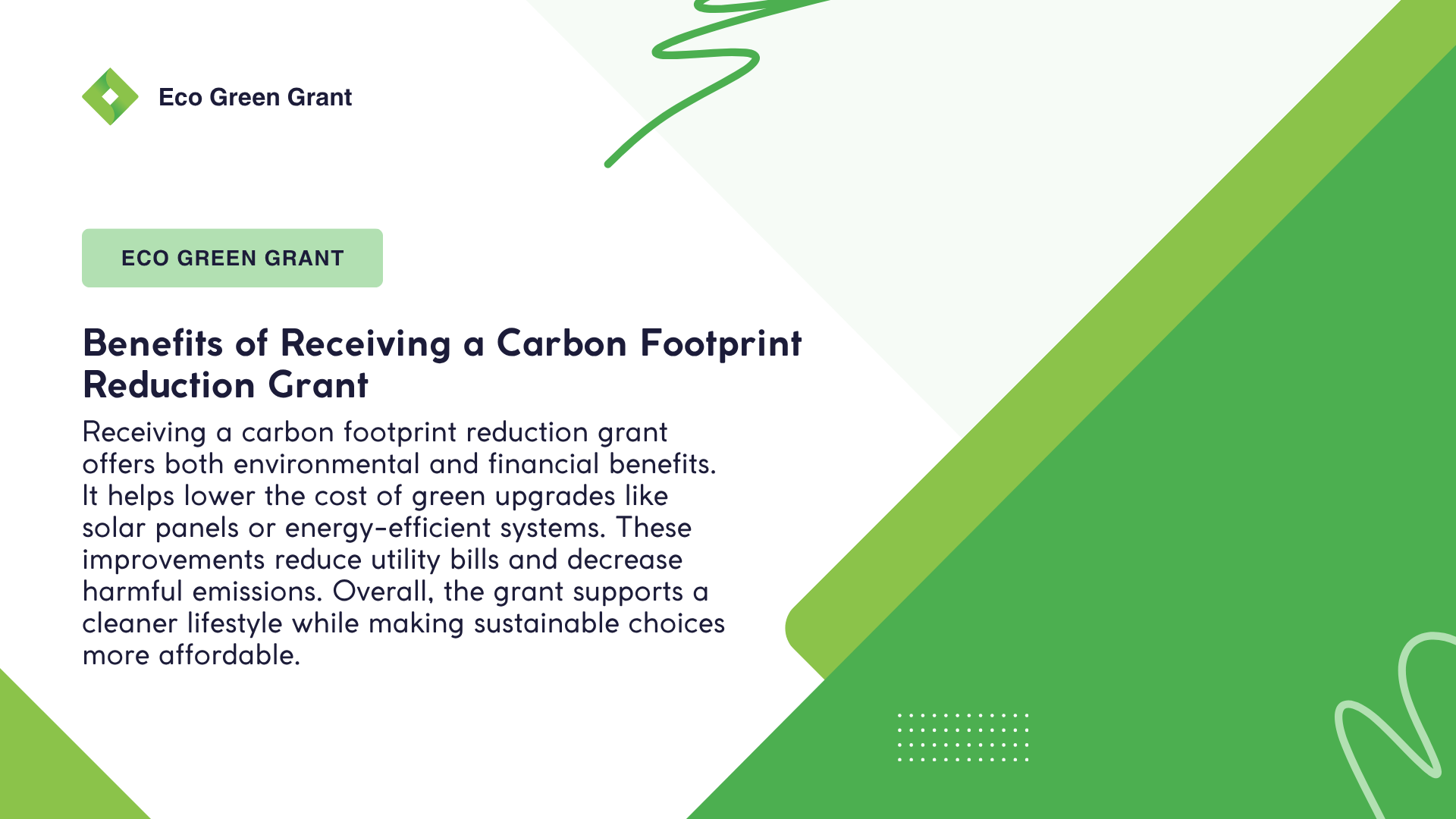Reducing your carbon footprint is essential for protecting our planet, and carbon footprint reduction grants make this easier than ever. These grants, including options like the Eco Green Grant, provide financial support for eco-friendly upgrades and projects. Whether it’s adding solar panels or improving insulation, help is available. This article will guide you through everything you need to know about these grants and how they can benefit you.
Understanding Carbon Footprint Reduction Grants

Carbon footprint reduction grants are financial aids designed to lower greenhouse gas emissions by funding eco-friendly projects. They help cover costs for renewable energy, energy efficiency, and sustainable transportation initiatives. These grants are available from governments and organizations alike, aiming to encourage widespread adoption of greener lifestyles.
What Are Carbon Footprint Reduction Grants?
These grants provide funds to individuals, businesses, or communities to help reduce carbon emissions through green upgrades. Projects might include solar energy systems or efficient appliances. The goal is to offset the upfront costs that often prevent people from adopting sustainable technologies.
Who Can Apply for These Grants?
Homeowners, small businesses, nonprofits, and even community groups can typically apply. Eligibility depends on the program, but many grants focus on supporting local residents and businesses that want to reduce their carbon footprints. Checking specific guidelines is crucial.
Benefits of Receiving a Carbon Footprint Reduction Grant
With a grant, you can lower initial expenses, save on utility bills, and contribute to a healthier environment. The Green Home Scheme, for example, helps make renewable energy more affordable. Over time, these projects often increase property value and promote sustainability.
Carbon footprint reduction grants provide practical support for eco-conscious individuals and organizations. They open doors to affordable green solutions, helping combat climate change effectively.
Types of Projects Funded by Carbon Footprint Reduction Grants

Grants support various projects aimed at reducing emissions, focusing on practical, impactful solutions. Knowing what qualifies can help you identify the right grant for your needs.
Renewable Energy Installations
Solar panels, wind turbines, and geothermal systems are common projects funded by grants. Installing solar panels on your roof reduces reliance on fossil fuels and cuts energy costs significantly. Such renewable energy projects contribute directly to lowering carbon footprints.
Energy Efficiency Improvements
Upgrades like better insulation, energy-efficient windows, or modern heating systems save energy and money. For instance, replacing old windows with double-glazed versions reduces heat loss. Grants often cover part of these improvements, encouraging homeowners to upgrade their homes sustainably.
Sustainable Transportation Projects
Grants sometimes support electric vehicle purchases, charging infrastructure, or bike lanes. Switching to electric cars or encouraging cycling reduces emissions from transport, which is a major pollution source. Community projects like public EV chargers receive significant grant support.
These projects are key to cutting emissions and building a greener community. Grants make such efforts achievable for many people.
How to Apply for Carbon Footprint Reduction Grants

The application process can be straightforward if you know what to prepare and where to look for funding.
Research Available Grants
Look for grants offered by local governments, nonprofits, and private organizations like the Eco-Friendly Government Grants. Check eligibility criteria, deadlines, and the types of projects supported. Start early to avoid missing out.
Prepare Your Application
Gather documents like proof of ownership, project estimates, and detailed plans. Explain how your project reduces carbon emissions clearly. Including examples, such as installing solar panels or upgrading insulation, strengthens your application.
Submit and Follow Up
Submit your application before the deadline and keep copies. Be prepared to answer follow-up questions or provide additional information. After approval, document your progress carefully, as many grants require proof of project completion.
Being organized and thorough increases your chances of receiving funding. Grants can help turn your green ideas into reality.
Real-Life Success Stories Using Carbon Footprint Reduction Grants

Stories of people and businesses benefiting from these grants can motivate you to take action.
A Family’s Solar Panel Installation
The Smith family in Oregon used a carbon footprint reduction grant to install solar panels. The grant covered 40% of costs, making it affordable. Their energy bills dropped by half, and their home became significantly more eco-friendly.
Small Business Energy Upgrade
A café in Texas received an Eco Green Grant to replace old kitchen equipment with energy-efficient models. This upgrade reduced electricity consumption and attracted eco-conscious customers, boosting their business and reducing emissions.
Community Bike-Sharing Program
In Vermont, a nonprofit secured a grant to launch a bike-sharing program. Residents switched from cars to bikes, cutting transportation emissions and promoting healthier lifestyles. This community project inspired nearby towns thanks to the Green Home Scheme.
These examples show how carbon footprint reduction grants can transform lives and communities for the better.
Tips for Maximizing Your Carbon Footprint Reduction Grant

Making the most of your grant ensures your project is both effective and sustainable.
Plan Your Project Carefully
Set clear goals, timelines, and budgets. Consider factors like weather or contractor availability when installing solar panels or upgrading insulation. Proper planning avoids delays and extra costs.
Combine Grants and Incentives
Look for additional programs like tax credits or rebates that work alongside grants. Stacking benefits increases overall savings, making larger projects more affordable and impactful.
Monitor and Share Your Results
Track energy savings and emission reductions after completing your project. Sharing your story online or with neighbors inspires others and supports a community-wide Energy-Saving Technologies in Nottingham green movement.
Thoughtful preparation and follow-through maximize the benefits of any grant program you join.
Common Challenges and How to Overcome Them
While helpful, grants may come with hurdles—knowing how to handle them is key.
Complex Application Processes
Some grants have detailed paperwork and strict requirements. Getting help from local agencies or grant advisors can simplify this and improve your chances.
Limited Funding Availability
Grants can run out quickly due to high demand. Applying early and considering backup financing options helps you avoid delays.
Project Maintenance and Follow-Up
Post-project upkeep is essential. For example, solar panels need cleaning to work efficiently. Reporting progress to grant providers ensures compliance and future eligibility.
Facing these challenges with preparation leads to successful, sustainable projects.
The Role of Eco Green Grant in Carbon Footprint Reduction
Eco Green Grant plays a significant part in making green projects possible for many people.
Supporting Diverse Projects
The Eco Green Grant funds a wide variety of projects, from small home improvements to larger community efforts. This broad approach encourages more people to participate in reducing their carbon footprints.
Making Green Technology Accessible
By offering financial support, Eco Green Grant removes barriers that often prevent people from adopting renewable energy and efficiency upgrades. This accessibility accelerates the transition to greener living.
Encouraging Long-Term Environmental Impact
Beyond funding, the Eco Green Grant provides education and ongoing support, helping projects deliver lasting benefits for the environment and local communities.
Eco Green Grant is a shining example of how financial support can empower sustainable change.
Future Trends in Carbon Footprint Reduction Grants

Understanding evolving trends helps you stay ahead and take advantage of upcoming opportunities.
Increased Focus on Community Projects
Grants are shifting toward neighborhood-wide initiatives like shared solar or improved public transit. These projects multiply environmental benefits by involving many people.
Integration with Smart Technologies
Funding for smart home devices and energy management systems is growing. These technologies improve efficiency by giving users greater control over their energy use and carbon emissions.
Emphasis on Equity and Inclusion
New grants aim to reach underserved communities, ensuring everyone has access to green solutions regardless of income or location.
Staying informed about these trends will help you capitalize on future grant programs.
How Local Residents Can Start Reducing Their Carbon Footprint Today
You don’t need to wait for grants to begin living greener—here are some simple ways to start now.
Energy-Efficient Habits
Switch off lights when not in use, choose energy-saving bulbs, and unplug devices to reduce waste. These habits make a big difference over time.
Small-Scale Home Improvements
Seal drafts around windows and doors and use programmable thermostats. These easy upgrades improve comfort and lower energy use.
Explore Grant Opportunities
Check out programs like the Eco Green Grant and government websites. Applying early can help fund bigger projects such as solar panel installation or EV chargers.
FAQs
What are carbon footprint reduction grants?
Carbon footprint reduction grants are financial aids offered by governments, nonprofits, or private organizations to help individuals, businesses, and communities reduce their greenhouse gas emissions. These grants typically fund renewable energy installations, energy efficiency upgrades, or sustainable transportation projects, making eco-friendly improvements more affordable.
Who is eligible to apply for these grants?
Eligibility varies by program but generally includes homeowners, small businesses, nonprofits, and community groups. Some grants target specific regions or income levels. It’s important to check the specific criteria for each grant to see if you qualify.
How can I find available carbon footprint reduction grants?
You can start by searching local government websites, nonprofit organizations, and programs like the Eco Green Grant. Many grants are also listed on dedicated environmental or energy efficiency portals. Early research helps you prepare and apply on time.
What types of projects do these grants typically support?
Common projects include installing solar panels, upgrading insulation or windows, purchasing electric vehicles, and building bike infrastructure. These grants encourage investments that directly reduce carbon emissions and improve energy efficiency.
Can small businesses apply for carbon footprint reduction grants?
Yes, many grant programs specifically support small businesses looking to reduce their carbon footprint through energy-efficient equipment upgrades or renewable energy installations. These grants can lower operational costs and attract environmentally conscious customers.
What documents are needed to apply for these grants?
Applications usually require proof of ownership, detailed project plans, cost estimates, and a description of how your project will reduce carbon emissions. Some grants might also require income verification or local residency proof.
How long does the grant application process take?
The timeline varies, but typically it can take several weeks to a few months from application submission to approval. Some grants have rolling deadlines, while others have fixed dates. Planning ahead is key to meeting deadlines.
What happens after my grant is approved?
Once approved, you should begin the project according to your plan and keep all receipts and documentation. Many grants require proof of completion and a final report showing how the project reduced your carbon footprint.
Are there any common challenges in using these grants?
Yes, challenges include complex application processes, limited funding availability, and ongoing maintenance of funded projects. Seeking help from local agencies and planning carefully can help overcome these obstacles.
How does the Eco Green Grant support carbon footprint reduction?
Eco Green Grant provides financial assistance for a wide variety of sustainable projects, making green technologies like solar panels and energy-efficient appliances more accessible. It also offers education and ongoing support to maximize environmental impact.






